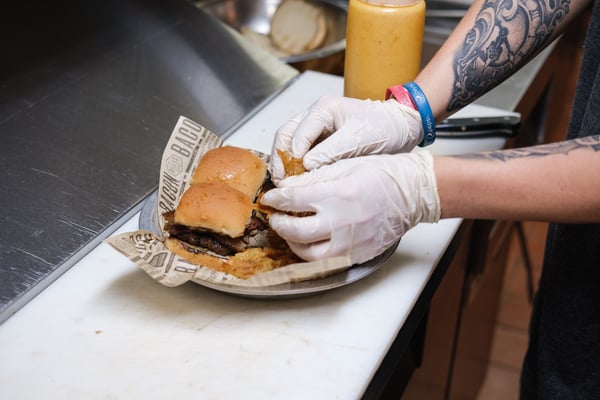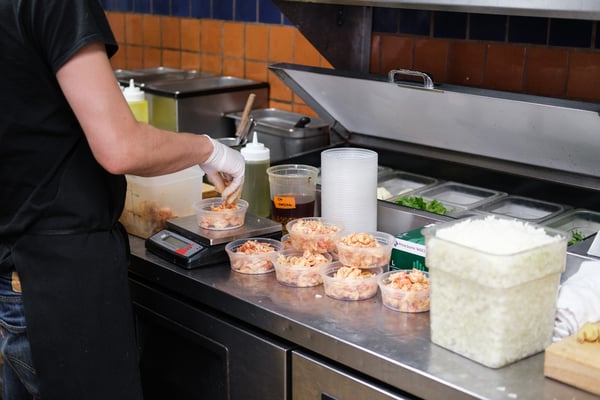A restaurant operator’s guide to actual vs. theoretical food costs and usage
Tracking food usage is a pivotal tool in the restaurant industry, where margins are slimmer than mandolin slices and require the same precision for success (and for keeping your fingertips intact).
[Download Now]: Food Waste Calculator
Regarding measuring and managing food usage, two key concepts come into play: actual and theoretical food costs. Understanding the relationship between these two measures is essential for optimizing operations, minimizing waste and controlling costs.
This blog aims to explore the concept of food usage in restaurants by looking at actual vs. theoretical food cost and variance, methods for calculating, common sources of increased food cost variance and solutions that will increase your bottom line.
By gaining a deeper understanding of this critical aspect of restaurant management, you will be better equipped to make informed decisions to improve profits and drive sustainable practices in your restaurant.
First, let's break down the definitions of actuals and theoreticals and their limitations.
A restaurant operator’s guide to actual vs. theoretical food costs and usage:
What’s the difference between Actual and Theoretical Food Costs?How to calculate actual vs theoretical food cost variance?
Common food waste culprits and how to combat them
Put the Excel down and back away slowly…
What’s the difference between Actual and Theoretical Food Costs?
Actual food costs
The cost as a percentage of sales of what is consumed and wasted in reality. This is measured by taking inventory at the start and at the end of a period. Actual usage includes what your guests eat, waste that ends up in the trash, marked-out items that don’t make it to the dining room for whatever reason and all those chef meals hastily eaten over a trashcan in the back during your 10-minute break. Another way to say this is the cost of goods sold (COGS).
Actual food costs are calculated using what you actually used (with the help of inventory!) during the time period you’re looking at.
(Beginning inventory + purchased inventory – ending inventory) x Product cost = actual COGS
COGS / menu price = actual food cost percentage
If you don’t have a restaurant management system (RMS) to do it for you, here’s a hack to help calculate and track actual food costs by hand.
Theoretical food cost
The cost as a percentage of sales of an estimated or projected amount of food used in a restaurant kitchen. It is calculated using purchased cost, recipe yields and number of items sold. This number assumes there’s been zero waste during prep and service (wouldn’t that be nice).
Product price / menu price = theoretical food cost percentage
Since theoretical costs are inherently incorrect, because no kitchen operates at 100% efficiency, why is it something operators track and look at? Well, theoretical food costs are used to measure efficiency, as well as identify problem areas (like theft or improper portioning) at the ingredient level.
How to calculate actual vs theoretical food cost variance?
 To better understand this, we’ll use an example.
To better understand this, we’ll use an example.
Your restaurant, Big Kahuna Burger, uses 8 oz. of ground beef for every Royale with Cheese. For simplicity’s sake, we’re just going to focus on ground beef. During the period we’re looking at, you paid $3.70 a pound for ground beef and sold 25 Royales with Cheese, so you should have spent $46.25 for them. You charge $9 per burger and your sales for those burgers were $225.
$46.25 / $225 = 20.5% theoretical food cost
Also for simplicity’s sake, let’s say this is the only food item you use ground beef for (we like things simple, what can I tell ya).
When you started this period, you had 20 pounds of ground beef on-hand. Based on recipe amounts, you should’ve used 12.5 pounds of ground beef for those burgers, leaving you with 7.5 pounds left over. When you take inventory, you find you only have 5 pounds left on-hand. This gives you your actual food costs because the inventory takes into account actual usage.
You actually used 15 pounds of ground beef, so your actual COGS was $55.50.
(20 - 5) x $3.70 = $55.50
$55.50 / $225 = 24.67% actual food costs.
The key to adding more money to your bottom line when it comes to actuals vs. theoretical is to maintain as low of a difference as possible between them (aka food cost variance). In the example above, we know our variance amount is 4.17%. Oof.
If the percentages were an exact match, you’d have zero waste and perfect portioning. Anyone who’s worked in a kitchen knows this isn’t possible, but that doesn’t mean you shouldn’t always be striving for it. Each little bit closer to zero you can get this variance is straight-up money in your pocket.
Now that you know why tracking the difference between actuals and theoretical food costs is important, let's look at some factors impacting food usage in restaurants and strategies operators can use to reduce the gap.
Common food waste culprits and how to combat them
Problem: Food spoilage
Things go bad. It’s a cruel lesson from the universe for all of us, but can be most uniquely felt by restaurant operators. You purchase three crates of lemons and find after a week that half of the second crate has gotten moldy and has to be thrown out. Even though you didn’t use those lemons in recipes for guests, you still already paid for them without turning a profit. Your fridge goes out, and you lose all that perishable product because the fridge guy can’t get there to fix it until Tuesday. Boom - food cost increases.
How to fix it:
There are a few ways to limit the amount of product lost to spoilage. The first is to have an efficient inventory system in place to track your product amounts. Weekly or monthly inventories help you not only calculate food costs but also keep an eye on product spoilage and usage.
With accurate on-hand amounts, you can purchase just what you’ll need between orders. Sometimes your vendors will have a great price on something and you’ll be tempted to stock up. If you’ve got the cash, freezer space or just extra space in general, then this might be a great way to save on costs.
If you don’t, you’re putting your restaurant at risk for over-purchasing things that will go bad before you can use them. By taking inventory regularly and looking at past sales data from your POS, you can get a pretty good estimate of what you’ll use each week and go from there.
.jpg?width=600&height=400&name=Smokecraft_0603-600x400-bf06395%20(2).jpg) Another way to limit product loss through spoilage is to find creative ways to use the excess product before it goes bad. This can be done through preservation methods like pickling, canning, or making jams. Pickled pork tenderloin and pork tenderloin jam? Who could resist?
Another way to limit product loss through spoilage is to find creative ways to use the excess product before it goes bad. This can be done through preservation methods like pickling, canning, or making jams. Pickled pork tenderloin and pork tenderloin jam? Who could resist?
Lastly, you should also work to maintain refrigeration equipment and have it serviced regularly. Many operators don’t have the cash on hand to fix a problem until it becomes a catastrophe, but investing a little more upfront can save you big time in the long run.
Problem: Cooking and ordering mistakes
Sometimes guests (or custies, as we lovingly like to call them), change their minds or don’t end up liking what they ordered. Sometimes kitchens make mistakes. That rare ribeye caught a little too much heat and is now a medium ribeye. A custie wanted their salad with dressing on the side, and it came fully dressed. As much as we strive for perfection and to make things right the first time, mistakes happen, and they can add up.
How to fix it:
In the case of meat being cooked to the wrong degree of doneness, simple tools like thermometers can make a big difference. Encouraging your waitstaff to help improve guest experiences by making custies feel heard by taking accurate orders can also help.
And what’s the best way to make sure your team is taking great care of your guests? By taking great care of your team. Lowering stress and fostering an environment where everyone feels supported to do their best work will help lessen mistakes. It can also help develop a deeper sense of ownership over their work and being supported by the restaurant, which can discourage theft. A win-win!
Problem: Food preparation and portioning
Food prep is probably the biggest culprit for accidental waste in a kitchen. This can happen when too much product is cut off during trimming, products are prepped incorrectly or portion sizes are inconsistent.
How to fix it:
Buy. Scales. Measuring ingredients by eye might work in Grandma Betty’s kitchen, but we highly doubt it’ll cut it in your restaurant if you are serious about improving food costs. Measuring products by weight is one of the best ways to maintain consistency (sorry, Imperial System fans). 
Weighing ingredients can help with everything from maintaining batch consistency for bulk prep items like sauces and batters to making sure protein portions are consistent every time.
Another crucial way to cut back on waste when it comes to prep and portioning is by investing in staff training. One of the easiest ways to do this is with the help of digital recipe books stored on tablets or recipe viewer systems. Look for digital recipe books that can scale yields built-in (no one needs to be doing math right before a busy service), and also allow you to add pictures or videos to show how prep should be done.
Problem: Seasonality and variations in ingredients
Strawberries in May are not the same as strawberries in December. Whole chickens from US Foods might be bigger or smaller than whole chickens from Sysco. If you’re ordering anything not sold by weight, there’s going to be some discrepancy due to seasonality or different vendors.
Seasonality and using different vendors can also cause issues both in quantity and quality. These issues can impact everything from prep amounts and recipe yields to guest satisfaction.
How to fix it:
Like with the previous problem and solution combo, writing recipes by weight can immediately help combat waste because it is a more consistent measurement than by each or by unit.
You can also look at making certain dishes most affected by ingredient quality and availability seasonal menu items or LTOs.
For more ways to lower restaurant food costs, check out this blog.
Put the Excel down and back away slowly…
Pinpointing the factors affecting your food costs might feel like navigating a culinary maze. With countless variables at play and a never-ending stream of daily tasks to manage, it's easy for operators to get lost in the chaos. But fear not, because there is an easier way than praying to the Excel gods and being a spreadsheet master, and it all comes down to implementing the right restaurant costing platform.
Look for an RMS with invoice processing automation that digitizes critical invoice data, smoothly integrates it with your restaurant chart of accounts and tracks actual and theoretical food costs for you. The right tool will help you say goodbye to guesswork and hello to crystal-clear insights into ingredient price fluctuations and their impact on recipes and plate costs.
So, when it comes to managing actual and theoretical food costs, reducing variance and taking full control of your restaurant expenses, a top-notch restaurant management system is your secret ingredient for maximum profitability.
[Download Now]: Food Waste Calculator

